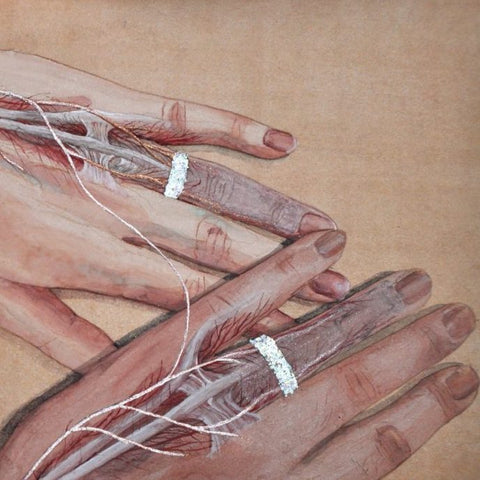HISTORY
The engagement ring is arguably the most popular and recognisable piece of jewellery of our time, made iconic by the symbolism it carries.
Yet references to exchanging marriage rings date as far back as Roman era, when the historian Pliny the Elder spoke about the tradition of couples exchanging a simple wedding ring. According to legend, the wedding ring was placed on the fourth finger of the left hand because this finger is located on the “vena amoris”, Latin for “vein of love”, which leads directly to the heart. However, as romantic as that may sound, a ring in Roman times was more symbolic of a contract between two people rather being a sentimental token of love.

Although this Roman custom of exchanging rings for a wedding led to the idea of giving a ring before the union, to formally symbolise the engagement, it was not until the 15th century that this practice became commonplace. Just as in Roman antiquity, the wedding ring was always a simple ring; the engagement ring, on the other hand, was decorated with gemstonesas is still the case today. In one of the earliest references to the existence of an engagement ring, in 1477, Maximilian of Austria is said to have given his fiancée Mary of Burgundy a gold ring set with a diamond. As cutting techniques improved over time, revealing more and more of the beauty of the stones, the use of gemstone rings has only grown in popularity over the centuries.

Imperial topaz and diamond ring
During the Middle Ages and the Renaissance, it was common to give a fede ring - which can be translated as trust in Italian - as an engagement ring. It consisted of one or two rings and represented two joined hands. This popular symbol can be found on the Claddagh ring, a ring of Irish origin depicting two hands holding a heart topped by a crown. During the sixteenth and seventeenth centuries, THE engagement ring was the gimmel ring, which consisted of two identical rings that fit together to symbolise union. They could also be separated and worn by each partner. Later, in the seventeenth and eighteenth centuries, the engagement ring continued to evolve, with rings set not only with diamonds, but also with rubiesemeralds or even sapphires. The latter were particularly popular, symbolising the purity of love through their celestial colour.
 Art Deco Sapphire and Diamond Ring
Art Deco Sapphire and Diamond Ring
It was in the 19th century that diamonds became the preferred gemstone for the engagement ring. This was partly due to the discovery of diamond mines in South Africa in the 1870s, which led to an influx of these stones into Western Europe, making them more affordable for young middle-class couples. The iconic solitaire, now recognised as THE classic engagement ring, is not only a symbol of love, but also of status.
In 1886 Charles Tiffany helped secure the diamond ring as the ultimate symbol of love when he introduced the Tiffany® Setting. This revolutionary new six-prong setting placed a single diamond high above the knife edge band, making the stone appear as if it was floating, and allowed light to enter the stone to showcase the diamond’s brilliance to maximum effect. It replaced the trend at the time for heavily embellished and ornate rings with gemstones set low against the band and was so sought after, and copied, that Tiffany and Co. had to release statements which warned customers against counterfeits.
Later in 1919 Marcel Tolkowsky developed the round brilliant cut, a combination of 57 kite and triangle facets to increase the light and brilliance of the stone, which complements perfectly the solitaire engagement ring style made popular by Tiffany’s. However, it was perhaps another world-famous jewelry company who cemented the idea of the iconic diamond ring as a symbol for everlasting love when in 1947 Frances Gerety, an advertising copywriter at De Beers, coined the simple and now famous four-word phrase “A diamond is forever”.

Marguerite Ring Diamonds, Early 19th century
WHICH DIAMOND FOR MY ENGAGEMENT RING?
Although white diamonds remain the classic colour for an engagement ring, diamonds can be found in every colour, including pink, green, lilac, brown, and yellow, with the rarest being red. There are examples of using coloured diamonds, known as fancy diamonds, throughout history, but it’s only in recent years that they have become a fashionable choice for engagement rings, perhaps encouraged by celebrities opting for pink and yellow diamonds for a more unique, coloured stone. If you’re choosing a classic white diamond be sure to pay attention to the 4 Cs – colour, clarity, cut and carat – as this will influence your choice of what to buy, and how much you will spend.

When deciding on a metal, brides-to-be can choose from yellow gold, rose gold, white gold and palladium white gold (which includes palladium for a whiter look) and more recently platinum, which is a rare, heavy, and very white metal which is well suited to an everyday piece such as an engagement ring as it very resistant to damage and wear and will never tarnish.
Brilliant cut remains the most popular and therefore the most expensive cut although diamonds exist in many different shapes: oldest one like the old mine and rose cut, or recent one like emerald cut, marquise, heart, oval, baguette, giving modern brides complete freedom to choose a shape, style, and colour which suits their budget and their own personal style.

